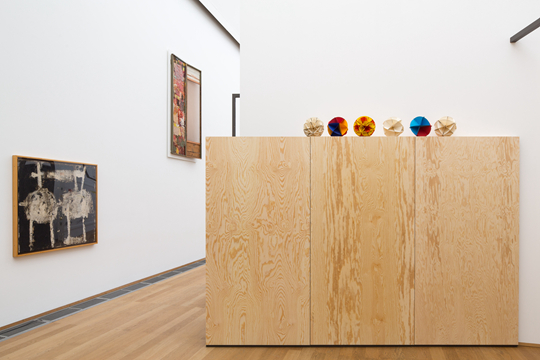BLACK MOUNTAIN COLLEGE: REHEARSING THE ARCHIVE
| November 10, 2015 | Post In LEAP 35

Courtesy Western Regional Archives, State Archives of North Carolina
PHOTO: Masato Nakagawa
Under a large emblem of Black Mountain College we read the list of well-known names who lectured there: Josef and Anni Albers, Robert Rauschenberg, John Cage, Willem de Kooning, Merce Cunningham, Albert Einstein. A schedule of performance is listed on a board around the corner, as if the legendary school still existed. The exhibition “Black Mountain College: An Interdisciplinary Experiment, 1933-1957” at Hamburger Bahnhof, Berlin, is a retrospective reviewing the history of the college. A Bauhaus-style temporary space is constructed with wooden planks and steel frames, showing Josef Albers’s famous Homage to the Square in a prominent position alongside the experimental music, drama, and poetry influenced by his color theory. Objects, images, and historical archives immediately bring to life the lesson plans of Black Mountain College.
Although the College ran for a short 24 years, its experiment has become a historical model for modern and contemporary art education. The exhibition guides visitors through the glorious history of a special period: Black Mountain was founded by four professors kicked out of the mainstream art institutions, 22 students, and 12 staffs in a meeting room in remote North Carolina with USD 14500 in raised funding.

The College invited Josef and Anni Albers, architect Walter Gropius, Swiss set designer Alexander Schawinsky, and others who had taught at Staatliches Bauhaus until they were persecuted by the Nazi regime to join the faculty, emphasizing the idea that art and life are inseparable, and teaching and practice have no obvious boundary. Students were free to choose any category of art and natural science courses. Additionally, they participated in collective labor, and created their work using the materials at hand. The Albers’s teaching focused on intuition and professional accomplishment—the unification of hand and mind through daily experience and practice. Albers considered logic the highest of forms, applicable to all forms of aesthetic experience. If one cannot comprehensively understand and extend the visual meanings of lines, shapes, colors, and textures, he cannot be a real artist. The only way to achieve this status was through the precision and order advocated by the Bauhaus movement. Intuition represents subjective perception, while professionalism is reflected as objective presentation. They must fuse with one another. The philosophy of Black Mountain College can be considered the model of modern art education, providing both theoretical nourishment and a practical program for art.

Courtesy Western Regional Archives, State Archives of North Carolina
Black Mountain College represented the embryonic form of the artist residency program. In the Berlin exhibition, a huge display board reviews the pastoral life of the College. Architect Buckminster Fuller led students to build geodesic domes inspired by methods of how builders might quickly set up temporary housing in disaster areas. In his My Diary in a Shaker Village, Chen Zhen describes his residency experience in a disappearing Shaker village in the early 1990s, when he understood that life and work become art through learning to weave baskets for the first time. The experience of living together with the locals from sunrise to sunset later became an important source for his theory of fusing and transcending cultural differences.
In the age of media then yet to come, the artist’s living experiences came from first-hand encounters with nature. In the scenes manipulated by today’s media, feelings of immediacy are more likely to comes from pseudo-understandings of time and space, meaning that art tends toward simulacra limited by homogenized and one-dimensional forms of daily life. The experiences of Black Mountain College were prescient. John Cage created Untitled Event/ Theater Piece No. 1 during a summer term. Robert Rauschenberg’s “White Paintings” were hung in the cafeteria as Merce Cunningham’s experimental dance pieces and Charles Olson’s poetry were presented, cups of coffee the served to audience by the waiters in white. While everyday visual experience has become complicated and confusing and individual feelings and memories of particular group events are intensified, has the everyday become more and more prominent in art? Today, in the field of contemporary art, site-specific presentations and an emphasis on process have infused many forms of expression, reigniting these discussions.

From conception to realization, the influence of Cage’s work is recognizable in “Performing the Black Mountain Archive,” a project in which students from various art institutions interact to conduct improvisational works in a special time frame. “The Dinner,” by a group of students from Hochschule fur Bildende Kunste Dresden, is considerably instructive. The top of a long dining table is formed by a paper model braced by the knees of 16 diners. Communication is not allowed during the dining process. A waiter wearing white gloves distributes scissors, balls of twine, and pieces of paper; diners must take a series of actions, eventually wrapping the table into a work of art using flesh-pink tape. During this process, a leader gives orders and participants work together to get the job done. This absurd scene simulates the collective experience of Black Mountain College, questioning the meanings of definition and ritual in different contexts of time and space. Rehearsing is itself a kind of experience and discovery. Meanwhile, a blog, Black Mountain Research, is continually updated. As Cage said, “I have left Black Mountain College for a long time, but I feel I’m always there.”
Text by Jiang Liyan
Translated by Xia Sheng

